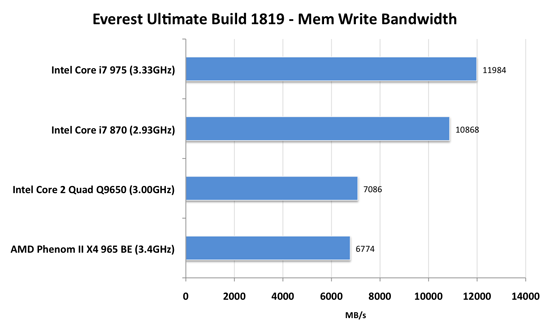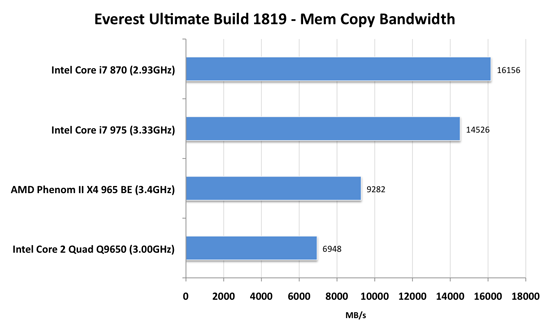Intel's Core i7 870 & i5 750, Lynnfield: Harder, Better, Faster Stronger
by Anand Lal Shimpi on September 8, 2009 12:00 AM EST- Posted in
- CPUs
Discovery: Two Channels Aren't Worse Than Three
Intel told me something interesting when I was out in LA earlier this summer: it takes at least 3 cores to fully saturate Lynnfield's dual-channel DDR3-1333 memory bus. That's three cores all working on memory bandwidth intensive threads at the same time. That's a pretty stiff requirement. In the vast, vast majority of situations Lynnfield's dual channel DDR3 memory controller won't hurt it.
Move up to 6 or 8 core designs and a third memory channel is necessary, and that's why we'll see those processors debut exclusively on LGA-1366 platforms. In fact, X58 motherboards will only need a BIOS update to work with the 6-core 32nm Gulftown processor next year. P55 looks like it'll be limited to four cores and below.
Because of this, Lynnfield's memory bandwidth and latency cores are actually quite similar to Bloomfield. I used Everest to look at memory bandwidth and latency between a Core i7 975 and Core i7 870 (Lynnfield):

Lynnfield's memory controller is good, easily as good as what's in Bloomfield if not slightly better.



Both processors turbo'd up to 3.46GHz, indicating that Everest's memory test uses no more than two threads. The 975 ran DDR3-1066 memory (the highest it officially supports), while the 870 used DDR3-1333. The faster memory gave the 870 the advantage. Since we're not taxing all four cores, Lynnfield is at no disadvantage from a bandwidth perspective. Surprisingly enough, even SiSoft Sandra (which does use four cores for its memory bandwidth test) shows Lynnfield's dual-channel DDR3-1333 memory controller as equal to Bloomfield's triple-channel DDR3-1066 interface.
| SiSoft Sandra 2009.SP4 | Intel Core i7 975 | Intel Core i7 870 |
| Aggregate Memory Bandwidth | 17.8 GB/s | 17.3 GB/s |
Long story short? Lynnfield won't be memory bandwidth limited with DDR3-1333 for the overwhelming majority of usage cases.










343 Comments
View All Comments
HexiumVII - Tuesday, September 8, 2009 - link
I must say that Lynnfield is the best stock processor ever. It will o/c itself without you having to touch it at all. Nearly perfect for the masses. I absolutely can't wait for the notebook incarnation.ClagMaster - Tuesday, September 8, 2009 - link
The performance of these processors is what I thought they would be based on your May Preview Article. Its great the NDA is lifted and we can now see what this processor can really do.This is hardly a Celeron. I know a troll in earlier Lynnfield/P55 that should be eating crow.
Apahutec - Tuesday, September 8, 2009 - link
Not sure what "core parking" priorities are (reduce power consumption by grouping tasks on active CPUs, or tune performance by taking into account cache trashing in scheduler decisions), but it sounds like it could even be beneficial on my Core 2 Quad: single socket, no HT, but two Core2 Duo (each with its own L2 cache) glued together.erple2 - Tuesday, September 8, 2009 - link
Sounds like it, but the logic that controls that on the CPU is on the CPU, and uses up a couple million transistors. That would require a re-spin of the Core 2 parts (which, given the P55 platform release, I think is a safe bet won't happen), however.Obsy - Tuesday, September 8, 2009 - link
I don't get how Turbo Boost ends "dual-core or quad-core?" I know that an on-die IGP is a selling point for the upcoming 32nm dual cores, but wouldn't they be clocked higher than these quads and have Turbo Boost too? There will be dual cores clocked higher than quads again. Or is Intel not clocking their dual cores past the speeds of quads?macs - Tuesday, September 8, 2009 - link
Would be interesting an article about P55 mobo with nf200 chip and 2 gpu...Ryan Smith - Tuesday, September 8, 2009 - link
We talked to NVIDIA about that scenario a couple of weeks ago. A NF200 chip would not make a significant difference in performance, which is why they're letting manufacturers go ahead and just split lanes with a straight-up bridge chip.Darkanyons - Tuesday, September 8, 2009 - link
Thanks for this great article!!Tomzi - Tuesday, September 8, 2009 - link
Do the PCIe controller's voltage demands impose stricter limits on undervolting in the case of Lynnfield processors compared to Bloomfield? I can run my i7 920 at stock frequncies undervolted to 0.9xx V VCore. How much voltage (power consumption) reduction can we expect from the an i5 750?This might not be a hot topic so close to the release of the new chips when everyone is focused on top performance comparisons but I've always been interested in undervolting/clocking and would like to see a more complete picture.
Tomzi - Tuesday, September 8, 2009 - link
750 and 870 undervolted by ~0.1V reported on silentpcreview.